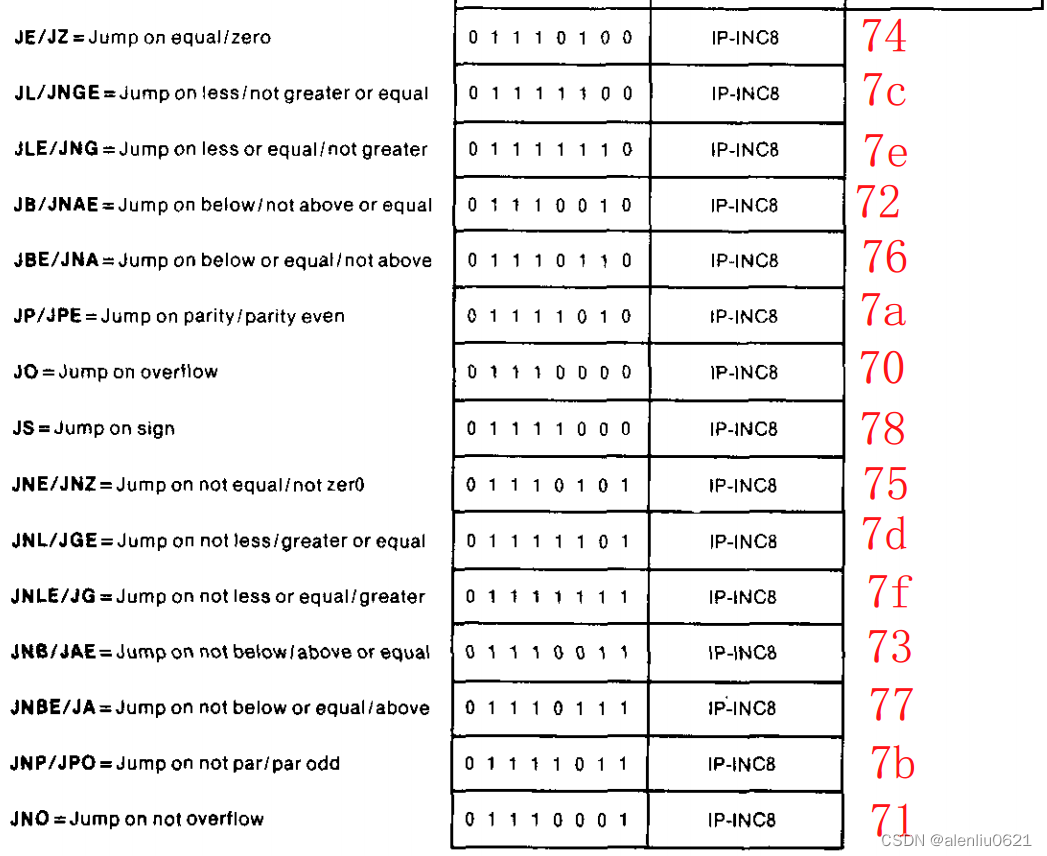这篇文章举例来讲讲 mov 指令和 jmp 指令解码函数的实现,其他的指令解码函数都与这些类似。
mov 指令解码
以 mov 指令中的一类:寄存器/内存 到/从 寄存器,来详细说明解码函数的实现。
机器指令格式如下:

各字段的含义如下:
w 1 bit w=0表示数据宽度是字节,w=1表示数据宽度是字
d 1 bit d=0表示reg是源操作数,d=1表示reg是目的操作数
reg 3 bits
REG W=0 W=1
000 AL AX
001 CL CX
010 DL DX
011 BL BX
100 AH SP
101 CH BP
110 DH SI
111 BH Dl
mod 2 bits
00 MemoryMode,nodisplacement follows
01 MemoryMode,8-bit displacementfollows
10 MemoryMode,16-bit displacementfollows
11 RegisterMode(no displacement)
rm 3 bits
MOD=11 EFFECTIVE ADDRESS CALCULATION
R/M w=0 w=1 R/M MOD=00 MOD=01 MOD=10
000 AL AX 000 (BX)+(SI) (BX)+(SI)+D8 (BX)+(SI)+D16
001 CL CX 001 (BX)+(DI) (BX)+(DI)+D8 (BX)+(DI)+D16
010 DL DX 010 (BP)+(SI) (BP)+(SI)+D8 (BP)+(SI)+D16
011 BL BX 011 (BP)+(DI) (BP)+(DI)+D8 (BP)+(DI)+D16
100 AH SP 100 (SI) (SI)+D8 (SI)+D16
101 CH BP 101 (DI) (DI)+D8 (DI)+D16
110 DH SI 110 DIRECTADDRESS (BP)+D8 (BP)+D16
111 BH DI 111 (BX) (BX)+D8 (BX)+D16
解码函数 decodeMovRegOrMemoryToFromReg 的目的就是将它转换为如下形式的中间指令格式:
指令类型,指令详细类型,[源操作数],[目的操作数]
decodeMovRegOrMemoryToFromReg 函数首先检测输入的机器指令的长度:
func decodeMovRegOrMemoryToFromReg(instructions []byte) []byte {
/* 0b100010dw,mod reg r/m, (DISP-LO ), (DiSP-HI)*/
decodegth := len(instructions)
if decodegth < 2 {
return nil
}
dispLen := lenDisplacement(instructions[1])
if decodegth < 2+dispLen {
return nil
}
....
}
由上文机器指令格式可知,这个指令至少有 2 字节长。如果长度达到 2 字节,再调用 lenDisplacement 获取偏移量的长度。如果指令长度达不到指令格式的要求,说明不是一条完整的指令,那就返回 nil。
lenDisplacement 的实现如下:
/* mod xxx r/m, (DISP-LO ), (DiSP-HI) */
func lenDisplacement(secondByte byte) int {
mod := (secondByte & 0b11000000) >> 6
rm := secondByte & 0b111
if mod == 0b11 {
return 0
}
if mod == 0b00 {
/* mov bx, [1]*/
if rm == 0b110 {
return 2
}
return 0
}
if mod == 0b01 {
return 1
}
return 2
}
就是根据 mod 和 rm 字段的含义返回偏移量的长度。
然后就是根据 d、w、mod、rm、reg 字段的含义,确定指令详细类型和操作数,将中间形式的指令格式返回:
decodedInstructions := []byte{
InstructionMov}
// return 2 + dispLen
d := (instructions[0] & 0b10) >> 1
w := instructions[0] & 0b1
mod := (instructions[1] & 0b11000000) >> 6
reg := (instructions[1] & 0b111000) >> 3
rm := instructions[1] & 0b111
switch mod {
case 0b11: //RegisterMode(no displacement)
if w == 0 {
decodedInstructions = append(decodedInstructions, MovReg8ToReg8)
} else {
decodedInstructions = append(decodedInstructions, MovReg16ToReg16)
}
if d == 0 {
//reg是源操作数
decodedInstructions = append(decodedInstructions, reg)
decodedInstructions = append(decodedInstructions, rm)
} else {
decodedInstructions = append(decodedInstructions, rm)
decodedInstructions = append(decodedInstructions, reg)
}
default:
if d == 0 {
if w == 0 {
decodedInstructions = append(decodedInstructions, MovReg8ToMemory)
} else {
decodedInstructions = append(decodedInstructions, MovReg16ToMemory)
}
decodedInstructions = append(decodedInstructions, reg)
decodedInstructions = append(decodedInstructions,
decodeMemoryOperand(mod, rm, instructions[2:])...)
} else {
if w == 0 {
decodedInstructions = append(decodedInstructions, MovMemoryToReg8)
} else {
decodedInstructions = append(decodedInstructions, MovMemoryToReg16)
}
decodedInstructions = append(decodedInstructions,
decodeMemoryOperand(mod, rm, instructions[2:])...)
decodedInstructions = append(decodedInstructions, reg)
}
}
return decodedInstructions
比如,当 mod 字段为 0b11 时,表示两个操作数都是寄存器,如果 d 为 0,那么 reg 字段就是源操作数,rm 字段就是目的操作数。如果 w 为1,那么操作数的宽度就是16位。这时候生成的中间指令格式为:
InstructionMov,MovReg16ToReg16 ,reg , rm
如果 reg 的值是 0,rm 的值是 1,这条指令的源汇编指令就是:
mov ax,cx
就是这么简单。
再看下解码 mov 立即数到内存/寄存器 解码函数 decodeMovImmediateToRegOrMemory 的实现:
func decodeMovImmediateToRegOrMemory(instructions []byte) []byte {
/*1100011w, mod 000 rm, [disp-lo] [disp-hi] data [data]*/
decodegth := len(instructions)
if decodegth < 2 {
return nil
}
w := instructions[0] & 0x1
dispLen := lenDisplacement(instructions[1])
dataLen := 1
if w == 1 {
dataLen = 2
}
if decodegth < 2+dispLen+dataLen {
return nil
}
decodedInstructions := []byte{
InstructionMov}
mod := (instructions[1] & 0b11000000) >> 6
rm := instructions[1] & 0b111
if w == 0 {
if mod == 0b11 {
decodedInstructions = append(decodedInstructions, MovImmediateToReg8)
decodedInstructions = append(decodedInstructions, instructions[2])
decodedInstructions = append(decodedInstructions, rm)
} else {
decodedInstructions = append(decodedInstructions, MovImmediate8ToMemory)
decodedInstructions = append(decodedInstructions, instructions[decodegth-1])
decodedInstructions = append(decodedInstructions,
decodeMemoryOperand(mod, rm, instructions[2:decodegth-1])...)
}
} else {
if mod == 0b11 {
decodedInstructions = append(decodedInstructions, MovImmediateToReg16)
decodedInstructions = append(decodedInstructions, instructions[2])
decodedInstructions = append(decodedInstructions, instructions[3])
decodedInstructions = append(decodedInstructions, rm)
} else {
decodedInstructions = append(decodedInstructions, MovImmediate16ToMemory)
decodedInstructions = append(decodedInstructions, instructions[decodegth-2])
decodedInstructions = append(decodedInstructions, instructions[decodegth-1])
decodedInstructions = append(decodedInstructions,
decodeMemoryOperand(mod, rm, instructions[2:decodegth-2])...)
}
}
return decodedInstructions
}
其他的都类似。
jmp 指令解码
jmp 指令包含直接转移和条件转移。
decode_jmp.go 中先把所有的指令详细类型定义出来:
const (
//非条件转移
JmpNotShort uint8 = iota //16位IP偏移量
JmpShort //8位IP偏移量
JmpDirectIntersegment //cs 16位,IP 16位
JmpReg16 //IP的值在寄存器中
JmpIndirectWithinsegment
JmpIndirectIntersegment
//条件转移
JmpJo
Jmpjno
JmpJb
JmpJnb
JmpJe
JmpJne
JmpJbe
JmpJnbe
JmpJs
JmpJns
JmpJp
JmpJnp
JmpJl
JmpJnl
JmpJle
JmpJnle
JmpJcxz
)
初始化函数,注册所有的 jmp 指令与它的解码函数:
func init() {
//jmp
AddDecodeInstruction(0xE9, decodeJmpDirectWithinsegment)
AddDecodeInstruction(0xEA, decodeJmpDirectIntersegment)
AddDecodeInstruction(0xEB, decodeJmpDirectWithinsegmentShort)
AddDecodeInstruction2(0xFF, 0b100, decodeJmpIndirectWithinsegment)
AddDecodeInstruction2(0xFF, 0b101, decodeJmpIndirectIntersegment)
var firstByte byte
for firstByte = 0x70; firstByte <= 0x7F; firstByte++ {
AddDecodeInstruction(firstByte, decodeJmpConditional)
}
//jcxz
AddDecodeInstruction(0xE3, decodeJmpConditional)
}
以段内间接转移为例,它的机器指令格式如下:

对应的解码函数 decodeJmpIndirectWithinsegment 代码如下:
func decodeJmpIndirectWithinsegment(instructions []byte) []byte {
/*11111111,mod 1 0 0 r/m,(DISP-LO ) (DISP-HI)*/
decodegth := len(instructions)
if decodegth < 2 {
return nil
}
dispLen := lenDisplacement(instructions[1])
if decodegth < 2+dispLen {
return nil
}
decodedInstructions := []byte{
InstructionJmp}
mod := (instructions[1] & 0b11000000) >> 6
rm := instructions[1] & 0b111
if mod == 0b11 {
decodedInstructions = append(decodedInstructions, JmpReg16)
decodedInstructions = append(decodedInstructions, rm)
} else {
decodedInstructions = append(decodedInstructions, JmpIndirectWithinsegment)
decodedInstructions = append(decodedInstructions,
decodeMemoryOperand(mod, rm, instructions[2:])...)
}
return decodedInstructions
}
如果 mod 是 0b11,则返回的中间形式机器指令为:
InstructionJmp,JmpReg16,rm
条件转移的解码函数就更简单,因为条件转移的机器指令固定 2 个字节:

只需根据第一个字节确定详细指令类型即可,它的实现如下:
func decodeJmpConditional(instructions []byte) []byte {
/*xxxxxxxx,IP-INC8*/
if len(instructions) < 2 {
return nil
}
table := map[uint8]uint8{
0x70: JmpJo,
0x71: Jmpjno,
0x72: JmpJb,
0x73: JmpJnb,
0x74: JmpJe,
0x75: JmpJne,
0x76: JmpJbe,
0x77: JmpJnbe,
0x78: JmpJs,
0x79: JmpJns,
0x7A: JmpJp,
0x7B: JmpJnp,
0x7C: JmpJl,
0x7D: JmpJnl,
0x7E: JmpJle,
0x7F: JmpJnle,
0xE3: JmpJcxz,
}
return []byte{
InstructionJmp, table[instructions[0]], instructions[1]}
}
其他指令的解码函数实现都类似。
后续文章讲解 EU 如何实现执行 mov,jmp 以及一些算数运算指令。